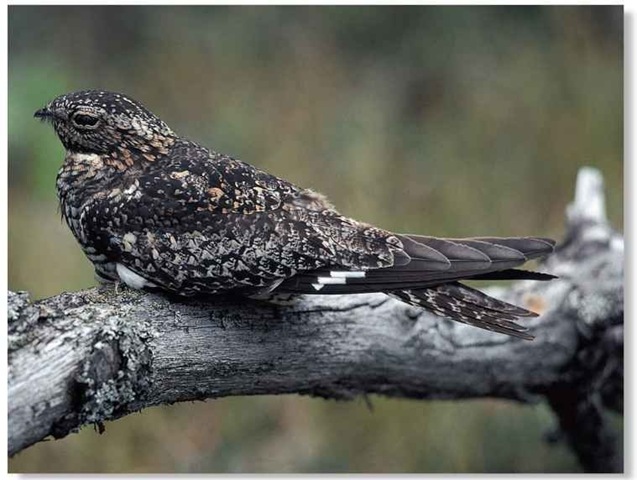ORDER
Caprimulgiformes
FAMILY
Caprimulgidae
GENUS & SPECIES
key features
• Leaves its roost at sundown to fly with its mouth wide open to scoop insects from the air
• Large eyes allow it to see well in poor light, as it seeks prey in dashing, hawklike flight
• Mottled plumage provides camouflage as it sleeps by day, disguised as a stump of a branch

where in the world?
Breeds in North and Central America (sub-Arctic Canada to Panama, the Bahamas and Greater Antilles); winters in South America (Colombia to northern Argentina)
LIFECYCLE
The “peent” call of the nighthawk joins the dusk chorus in many American cities, as this bird sets out on its zigzagging flight, twisting to and fro through swarms of flying insects.
HABITAT
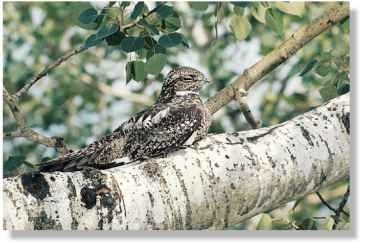
The nighthawk is a country bird A Out on a limb that has prospered in town. It The nighthawk’s patterned favors open spaces; common plumage conceals it by day.
rural habitats include barren,
rocky land, pebble beaches and farm fields.The nighthawk is also found in large clearings of forested areas. Its love for conifer country laid open by forest fires has given it the name “burnt-land bird.”
The nighthawk likes stony nesting sites and started to spread to towns after the first buildings with flat, graveled roofs were erected in the 19th century. Roof nests are less vulnerable to predators, so now more nighthawks breed in towns than in the country.
• Rooftop nests may fail in hot weather when eggs get stuck in sun-warmed tar.
# The nighthawk’s booming call has been compared to the sound made by blowing in the mouth of a soda bottle.
• In the 1880s, many nighthawks paid for their name with their lives when game commissioners in Pennsylvania felt obliged to allow bounty to be paid on them simply because they were called hawks.
FOOD & HUNTING
The nighthawk is a voracious eater of flying insects, all of which are captured on the wing as the bird twists through the air with its wide mouth open. Although the nighthawk hunts mostly for short periods, it catches large amounts of insects rapidly. It needs to — it uses a lot of energy during its zigzagging flight. One bird was found to have more than 2,000 flying ants in its stomach.
Moths and mosquitoes also figure high on a menu that may include grasshoppers and beetles. Some insects, such as Colorado beetles and weevils, are agricultural pests. As a result, the nighthawk, once wrongly accused of killing poultry chicks, is now regarded as a friend by farmers.
HAWKING BY NIGHT
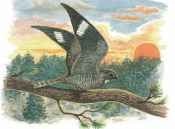
1 Take off…
As the sun falls below the horizon, the nighthawk flies up from its daytime resting place.
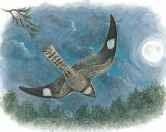
2 Zigzag…
The nighthawk zigzags through the air, seeking insects that still linger in the fading evening sky.
BEHAVIOR
The nighthawk is active at dawn and dusk, but may hunt in daylight, particularly in overcast weather. It normally sleeps by day, perched lengthwise on a branch so it resembles a broken stump. Its mottled plumage renders it almost invisible against tree bark.
The nighthawk also relies on camouflage at its nest. Only at the last moment will it react to an intruder, either by scaring it by opening its gaping mouth and hissing with wings raised or by feigning injury to distract the predator from its brood.
On its breeding grounds, the bird is normally seen singly or in pairs but large flocks gather at migration times.
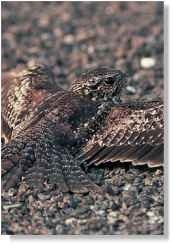
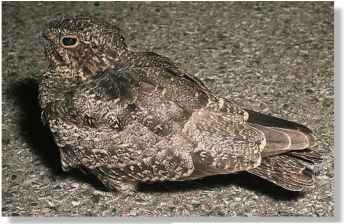
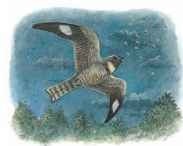
3 Catch…
Closing in on a swarm of flies, it opens its mouth wide and scoops in the insects.
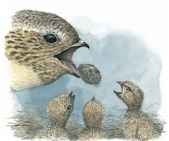
4 Feed
An adult with young carries a balled mass of captured insects back to the nest in its throat.
CONSERVATION
The nighthawk’s fast, erratic flight made it a popular target for 19th-century hunters. Many were shot during their annual migration through the southern U.S., where roast “bullbat” was prized as a delicacy until the species gained protection a century ago. Recent studies have shown declines in populations — the cause of which is under investigation.
BREEDING
The nighthawk reaches its North and Central American breeding grounds in spring, after a winter spent in warmer southern climates. By the time it arrives, most other bird species have begun to breed.
A spectacular feature of the male’s courtship display is his “dive-and-boom” routine. He swoops toward his mate as she rests at their breeding site. As he veers abruptly upward, only a few feet above her, air rushing through his wing feathers produces a roar that gave the bird its old names of “bullbat” and “booming nighthawk.” When he lands near his mate after his aerial display, he wags his fanned tail and rocks his body while making a deep croak as he expands his white throat patch.
The female lays a clutch on bare ground, a rooftop, even an old fence rail. The female incubates the eggs, but the male helps her feed the young. Parents regurgitate insects directly into the throat of each chick. In about one month, chicks can feed themselves
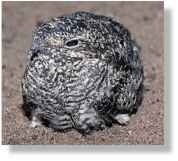
A Mottled minor Like adults, the chick has camouflaging plumage.
Open-plan nursery Nighthawks rear their chicks on bare ground.
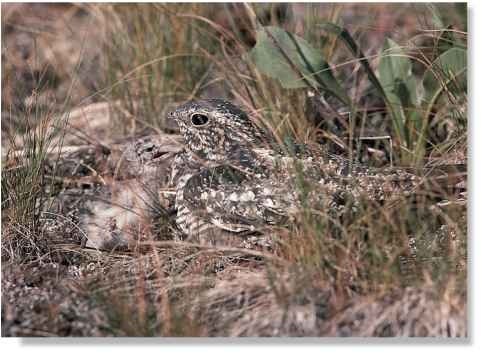
Bold defender A nesting adult spreads its wings defensively.
PROFILE
Common Nighthawk
The nighthawk has long, pointed wings for fast, agile, falconlike flight and a highly specialized bill for scooping insects out of the skies.
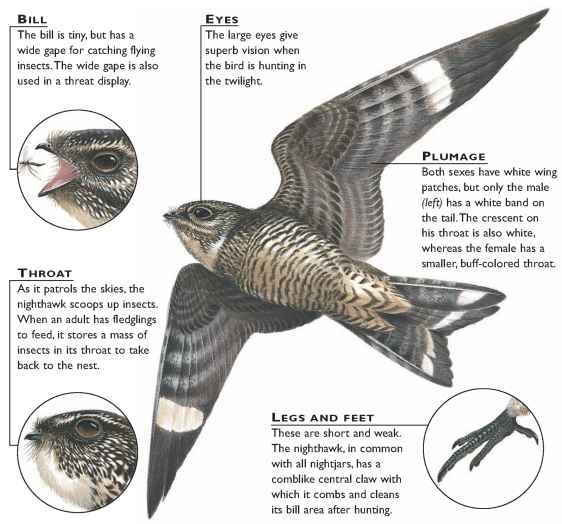
CREATURE COMPARISONS
The nightjar family has similar species (the common nighthawk and European nightjar) around the world. All have long, pointed wings, a short bill and wide mouth. The male pennant-winged nightjar is one of several species with bold plumage: 2′-long wing feathers trail from its wings as it flies over the African savannah.
Common nighthawk
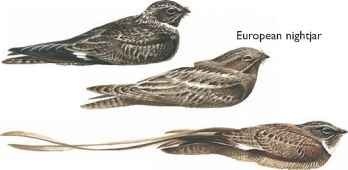
Pennant-winged nightjar
| vital | |
| statistics | |
| Weight | 2.5-2.75 oz. |
| ‘ Length | 9-9.5″ |
| Wingspan | 21.5-26″ |
| Sexual Maturity Breeding Season |
1 year March through August |
| Number t of Eggs | 2 |
| Incubation Period | 14-19 days |
| [ Fledging Period | 18-22 days |
| Breeding 1 Interval | 1 year |
| Typical Diet | Flying insects |
| ; Lifespan | Up to 6 years |
Related species
• The common nighthawk is one of eight nighthawk species in the Americas. All belong to the nightjar family Caprimulgidae, including the American whippoorwill and Old World (African and Eurasian) nightjars. There are 76 nightjar species distributed throughout the world. Most have long, stiff bristles surrounding the mouth that aid in the capture of insects.
